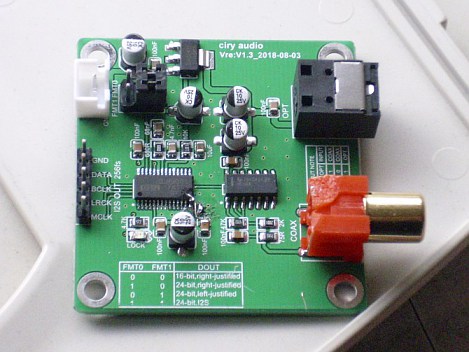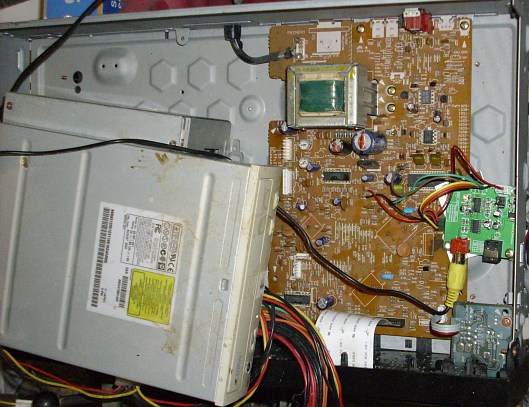
DIR9001 S/PDIF receiver board modified for 384fs master clock output
It's barely worth posting this really since all it amounts to is putting Lego together, but here we go anyway...
My Pioneer PD-204 CD player ceased to function. This was extremely dead and chewed. The fault was that the output from the optical pickup was decreasing in amplitude over time (at a rate of a few tens of millivolts per month), for no reason that I could fathom, so that the data slicer was having increasing difficulty recovering the signal. First CD-Rs started jumping and skipping, then proper ones started doing it, and eventually nothing would play at all. So I made a wee RF amplifier to boost the signal back to its proper level. That worked for a while, but the input signal amplitude was still gradually decreasing and after a couple of months the fault came back. Fiddling with the laser power made absolutely fuck all difference, and since it was clear that further boosting the signal was not a long term solution I decided it wasn't worth fucking around.
As a temporary fix I tried using a computer CD drive with its analogue audio output plugged into the stereo, which did work, but the built-in DAC in the CD drive was absolutely fucking shite and the sound quality was awful, so it was a long way from being satisfactory to listen to. So basically I didn't.
However, many computer CD drives, including this one, have a digital audio output (S/PDIF) as well as an analogue one. And since the DAC in the Pioneer CD was still just fine, the obvious solution was to use the Pioneer DAC with the CD drive as the digital source. All I had to do was rewire the Pioneer board to feed the DAC from an S/PDIF receiver instead of from its existing decoder. This would also make it possible to connect the computer to the stereo via an optical S/PDIF cable, so I could play music from the computer through the stereo without the usual arseache of contamination of the audio signal with digital noise that you can't hear on the usual crappy computer speakers but ruins the whole thing when you put it through a decent stereo, and also without any problems with ground loops and all that shite.
The Burr-Brown DIR9001 is a well regarded and widely available S/PDIF receiver, with all sorts of fancy jitter elimination gubbins, and also with enough flexibility to produce a master clock (recovered from the S/PDIF signal) at 384fs to suit the Pioneer DAC; most S/PDIF receivers either won't do this at all or won't do it without having to fuck around using a microcontroller to send them setup commands digitally at power-up. The DIR9001 will do it on its own if you hardwire the configuration pins appropriately, so that was great.

Poking around on ebay I found loads of people selling the DIR9001, priced at around a tenner plus/minus a quid or so. I also found a few people in Hong Kong selling a wee board with a DIR9001 and an optical S/PDIF connector and all the other bits and pieces needed to make a complete functioning unit, also priced at around a tenner. Effectively it was the same board that I had been intending to make up, complete, for the same price as just the main component. It even comes with a handy set of little patch leads to connect it up with. So I got one of those.
It wasn't quite what I wanted: the configuration pins on the DIR9001 had been hardwired to produce a 256fs master clock instead of the 384fs clock I needed. But this was easily solved, by cutting the track leading to pin 13 and lifting pin 14 from the board, then wiring pin 13 to ground and pin 14 to positive (ie. the opposite way round from how it was made). Bit fiddly because it's a 0.5mm pitch surface mount package but perfectly feasible, even if I did melt the corner of the phono socket catching it with the soldering iron, but bugger that. (Tools used: the same 25W iron with 3mm bit that I use for everything, a Stanley knife, and a 15x magnification eyeglass to check the results. No, you do not need anything exotic or expensive to do things like this.) It was also necessary to reconfigure it to produce a 16-bit output, but there are jumpers provided for this.

The standard arrangement in a CD player is for the master clock to be generated by the DAC, and fed to the decoder which then supplies the DAC with a bitstream timed to it. With the data coming from an S/PDIF receiver it's the other way round: the original master clock is generated by whatever the S/PDIF signal is coming from, and the S/PDIF receiver recovers a clock signal from the S/PDIF stream and generates from that the master clock signal which is then fed to the DAC. Therefore it was necessary to remove the 16.944MHz crystal on the Pioneer board that originally provided the clock source for the DAC, and replace it with a 1-pin header on the non-driven side (pin 13 on the DAC) to connect the master clock provided by the DIR9001 (this is the brown wire in the photo). Another 1-pin header installed in a hole that would have been one lead of a capacitor on a different variant of the CD player provided the data ground connection (green wire in the photo). Conveniently, the BCLK, LRCLK and DATA signals from the decoder to the DAC went through jumper wires at one point, so it was easy to remove the jumpers and add a 3-pin header at that point to connect the signals from the DIR9001 (orange/red/yellow wires). There are also jumper wires that provide easy access to +5V and ground to power the DIR9001 (red and black wires). Finally, a blob of solder across Q405 base and collector disables the muting circuit.
And that was it. The photo above right shows the board hooked up to the Pioneer board, with the computer CD drive propped up on top of a PC PSU on the left to see if it all worked. And it does.
Click the photo for a closeup of the alterations to the Pioneer PCB. Q405 is at the upper left, bent over on its side, between Q452 and the large electrolytic capacitor. The white things under the DIR9001 board are pieces of a rail ticket cut up and used as precautionary insulation.
None of the controls on the CD player do anything any more. The control processor won't even boot without the CD mechanism present, and just sits there with all the segments on the VFD continuously and meaninglessly lit. This does not matter. It starts working when you plug it in, without further intervention, and that's what counts.
Useful information that I used:
DIR9001 datasheet
Pioneer PD-204 service
manual (includes circuit diagram)
SM5871 DAC datasheet -
Note this is not the DAC used in the PD-204 - that is a PD2026B
- and in particular the pinout is not the same. But it is similar
enough to be not entirely useless.
Back to Pigeon's Nest
Be kind to pigeons